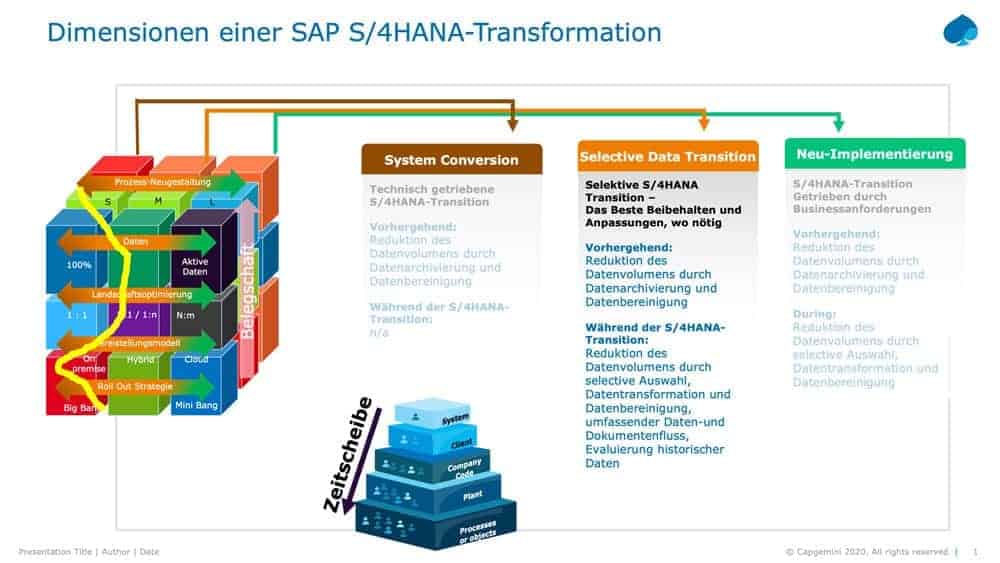Aligning with the pain points of the business
![[shutterstock: 1788177956, Andrii Yalanskyi]](https://e3mag.com/wp-content/uploads/2021/01/shutterstock_1788177956.jpg)

A look at the development of SAP S/4HANA in companies shows: Only one in five midsize companies (with 500 to 5000 employees) is already using SAP S/4HANA. According to a recent study by techconsult, nearly half of large companies with more than 5,000 employees do.
The reasons are that many companies that still have to make the switch to SAP S/4HANA fear a long changeover period (42 percent) and high costs (42 percent). In addition, there is a lack of internal expertise for the new software (49 percent).
techconsult: SDT is now a popular path to S/4HANA
One approach that is becoming increasingly popular among companies is selective data transition (SDT): While a brownfield approach largely preserves process and IT architecture structures and continues to use historical data, and the greenfield approach is closely aligned with the SAP standard, SDT is a kind of middle ground.
For example, only selected processes are transferred from SAP ECC to SAP S/4HANA and implemented in an agile process, or a new system is set up but legacy data is taken with it. With the selective approach, it is necessary to check not only the master and transaction data, but also how the customer's own applications are handled. Capgemini advises its customers to choose a system architecture that supports solutions both within and outside SAP.
For the so-called multi-pillar system architecture, there are more and more customer examples in which such a set-up was chosen - even before the actual switch to S/4HANA. Market researcher Lündendonk found just a year ago that only 18 percent of companies preferred the selective approach, while the majority of 57 percent opted for brownfield.
Meanwhile, figures from techconsult from this year show that 34 percent of companies planning to switch to SAP S/4HANA are already using selective data transition. Of all companies that are currently using SAP S/4HANA, the figure is as high as 39 percent. Even SAP now says that one in four companies is using SDT. One thing is clear: selective data transition has become a popular migration strategy.

Small transformation packages instead of large-scale project
For managers, the focus is on return on investment. They demand planning security, low risk, short project cycles, and that the investments pay off as quickly as possible. An SAP S/4HANA project must not become a major project à la Berlin Airport. That is why Capgemini usually defines smaller transformation packages with concrete and measurable "deliverables" - individual services that provide for a migration with an SDT approach for processes, data or organizational units at closed intervals, for example.
Important points of reference are the total cost of ownership and the time to value.
Total cost of ownership: The total cost of ownership is an established KPI in digitization projects. Compared to greenfield projects, which require a complete redesign of all business processes, 80 percent lower costs are possible, according to the experience of SAP partner Capgemini.
The reason for this is that only the historical data that is really needed is taken along, potential savings for data storage are identified, and the leanest possible S/4HANA system is made possible. At the same time, historically grown processes that support the core business are reused and individual processes - selectively - redesigned. Rule of thumb: If two-thirds of the existing processes can be retained, the selective data transition proves to be the most cost-effective migration option.
Time to value: In Capgemini's experience, project times are reduced by more than 50 percent, and time to value is shortened accordingly. For example, since only individual processes are migrated, downtimes in the transition from the old to the new world are reduced. In addition, harmonization projects are not absolutely necessary because data and processes are migrated selectively. Another plus: Go-lives are possible gradually at intervals. The new value of a migration is thus already noticeable after each partial stage.
Quick assessment: migration selection via slider bar
How to find out if selective data transition is a good fit for the business? For Capgemini, selective data transition means first finding the relevant pain points in the company. As a first step, we rely on a quick assessment to determine which path is best for the company from a bird's eye view.
The greater the willingness for process reengineering and data in real-time applications as well as openness for the cloud, the greater the willingness for a standardized system landscape and go-lives in several steps, the more suitable the company is for Greenfield. The less a company can or wants to go down these paths, the more Brownfield comes into question.
As if on a slider, this determines which migration strategy tends to fit best between the brownfield and greenfield extremes. In the middle of these two poles is the selective data transition.
Why companies rely on selective data transition
A chemical company, which approached Capgemini on its own initiative, also fell into this "prey grid". The company was dissatisfied with its inventory management and opted for selective data transition. Why? Migrating the entire SAP system to S/4HANA also meant that various departments would be affected - and with them financial processes, product planning, quality management and master data. To avoid this, the company focused selectively on the processes that were relevant for inventory management.
Inventories fell and millions of euros were saved without turning the "big wheel" of enterprise-wide S/4HANA implementation. Another not entirely unimportant topic is industry solutions that could previously be used reliably as an add-on in SAP ECC, such as Dealer Business Management, but no longer in S/4HANA. The solution for the automotive industry covers diverse processes of the automotive trade from the sale of vehicles to the spare parts store and workshop operations.
System conversion is not supported for the add-on, in the greenfield approach you would have to redesign the processes - so the only thing left is data transition. Whether add-ons are industry solutions or not, there are more and more of these examples of selective data transition, especially because even large companies are now getting "serious" about converting to S/4HANA. Many companies have migrated rather non-critical processes to S/4HANA so far - that is changing. The trend, as shown by figures from techconsult, SAP and the American SAP User Group ASUG, is clear: SDT is becoming more important.





